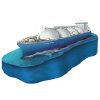- Aboveground crossing
- Accident
- Aeration tank
- Aggressive (corrosive) water
- Air cooler
- Arctic pipelines
- Associated petroleum gas
- Back-stripping analysis
- Barbotage
- Barrage
- Barrel
- Bio-indication
- Bottomhole zone
- Box-and-pin joint (tool joint)
- Carbon black
- Casing string
- Catagenesis of organic substance
- Cavernosity
- Clogging
- Column equipment
- Comprehensive gas treatment unit
- Compressed natural gas filling stations
- Compressing
- Compressor station
- Condensate recovery factor
- Connector
- Core sample
- Correlation
- Corrosion
- Cratering
- Directional drilling
- Distillation-based separation of multi-component fluids
- Diversification
- Drilling
- Drilling (penetration) rate
- Drilling rig
- Dry gas
- Expander
- Extreme anhydrous depression
- Failure in gas industry
- Field development techniques
- Fishing tool
- Flammability limit
- Flare unit
- Fluid
- Fluid dynamics
- Flushing out of well
- Fore deep
- Formation
- Formation pressure
- Formation testing
- Fossil (stratum, reservoir, formation) water
- Free (non-associated) gas
- Free-piston pumping
- Fuel equivalent
- Gas absorption
- Gas adsorption
- Gas cap
- Gas condensate fields
- Gas consumption rate
- Gas deposit water cut
- Gas desorption
- Gas disposition terminal
- Gas distribution network
- Gas distribution plant (GDP)
- Gas engines
- Gas hydrates
- Gas hydrates self-conservation
- Gas interchangeability
- Gas jet ejector
- Gas linepipe
- Gas macrojamming
- Gas processing plant
- Gas separation
- Gas stripping
- Gas supply to consumers
- Gas throttling
- Gas tongue
- Gas transmission system
- Gas trunkline
- Gas-water contact (GWC)
- Gasholder
- Geological exploration risk
- Geological formation
- Geological prospecting
- Gravity exploration
- Greenhouse gases
- Helium
- Horizon
- Hydraulic fracturing
- Hydrocarbons
- Hydrogen index (pH)
- Hydrogenation
- Injection capacity of a well
- Kharasaveyskoye field
- Kovykta field
- Lateral coning
- Lift string
- Line pipe operation center
- Liquefied natural gas
- Lithology
- Logging
- Long-distance gas transmission
- Looping
- Low-temperature separation of gas
- Magnetic prospecting
- Main gas generation phase (MGGP)
- Main oil generation phase (MOGP)
- Medvezhye field
- Membrane technology
- Methane
- Methanol
- Mobile CNG station
- Mofettes
- Natural gas dew point
- Natural gas production
- Natural gas purification
- Natural gas vehicles (NGV)
- Natural pressure gas lift operation
- Natural reservoir
- Octane rating
- Odorant
- Offshore fields exploration
- Oil and gas formation
- Oil and gas reservoir
- Oil rim
- Oil-water contact (OWC)
- Oil/gas blowout
- Orenburg helium refinery
- Packer
- Pad distribution
- Passivization
- Phase
- Phase transitions of hydrocarbon gases
- Pipelaying vessel
- Pipeline accessories (valves and fittings)
- Pipeline route
- Pipeline watercourse
- Pipelines ballasting
- Plugging material (backfill)
- Preventer (blow-out equipment, BOE)
- Producing (pay) horizon
- Prospective resources
- Raw gas
- Reamer
- Regasification
- Repression funnel
- Reserves
- Reserves-to-Production Ratio (RPR)
- Reservoir depression
- Reservoir energy
- Reservoir gas of condensate accumulations
- Reservoir impermeable seal
- Reservoir temperature
- Retrograde phenomena
- Riser string
- Rock gas saturation
- Satellite soils monitoring
- Secondary (enhanced) recovery methods
- Seismic exploration
- Skin-effect
- Sorption
- Spot trading
- Stabilized condensate
- Standard conditions
- Stray currents
- Subsurface use licensing
- Swivel
- Synthesis gas
- Take-or-pay
- Tubing string
- Unified Gas Supply System
- Unstabilized condensate
- Viscosity
- Well
- Well cementing
- Well deviation
- Well recompletion
- Well stock
- Well suspension
- Wellhead pressure
- Western Siberia oil and gas bearing province
- Working gas
- Zapolyarnoye field
Liquefied natural gas (LNG) is natural gas transformed into a liquid phase at a temperature below critical. LNG is a cryogenic fluid produced from natural gas by refrigeration down to condensation temperature −161.5°С. Temperature of crystallization is minus 182.5°С, density – 0.42 kilograms per liter. It is produced, stored and transported by specialized cryogenic equipment. The main LNG advantage is that the volume of gas is reduced 600 times. Practically, it means that the same volume contains 3 times more LNG than compressed natural gas (CNG) at 20 MPa pressure. For example, a 50 liter automobile gas cylinder in normal conditions and at 20 MPa pressure contains 10 to 12 cubic meters of natural gas in a gaseous phase, which is equal to 12 to 15 liters of gasoline. LNG is produced in liquefaction facilities by refrigeration and cryogenic cycles, including the use of energy from pressure difference at gas distribution stations (GDS) and at compressed natural gas (CNG) filling stations.

